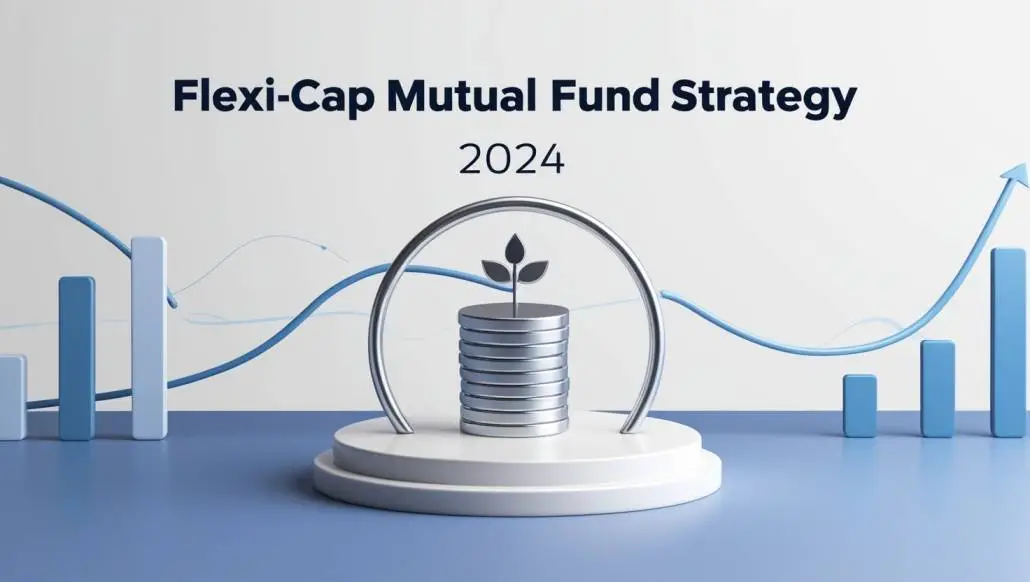Introduction
Investing in mutual funds can feel like walking into a buffet with endless choices. Flexi-cap mutual funds are a flexible option. They adapt to changing markets and offer both stability and growth.
Understanding the Basics of Flexi-Cap Mutual Funds
Flexi-cap funds invest in large, mid, and small-cap stocks without fixed allocations. This lets fund managers adjust to market changes. It ensures your money works well.

Differences Between Flexi-Cap and Other Equity Funds
- Large-Cap Funds: Focus on big, stable companies.
- Mid-Cap Funds: Look at mid-sized companies with growth chances.
- Small-Cap Funds: Invest in small companies with high risk but big returns.
Flexi-cap funds mix these, offering the best of all.
How Flexi-Cap Funds Work
These funds use a dynamic model. In good times, they might focus on mid or small-cap stocks for growth. In bad times, they might choose large-cap stocks for safety.
Advantages of Flexi-Cap Mutual Funds
Flexi-cap funds have many benefits for investors.
- Diversification Benefits: They spread out investments across different sizes, reducing risk.
- Risk Mitigation: They can adjust to market changes, reducing losses.
- Adaptability: Managers can quickly respond to market shifts, finding new opportunities.
Who Should Invest in Flexi-Cap Funds?
These funds are good for many investors.
- Those wanting a mix of growth and stability.
- Long-term investors are aim to grow their wealth.
- People seeking professional management and adaptability.
Key Factors to Consider Before Investing
Before investing, think about these:
- Fund Manager Expertise: A good manager is key to success.
- Past Performance: It shows the fund’s history.
- Expense Ratios: Lower ratios mean more of your money stays invested.
- Investment Horizon: They’re best for medium- to long-term goals.
Tax Implications of Investing in Flexi-Cap Funds
It’s important to understand the tax side:
- Short-Term Capital Gains (STCG): Gains from less than a year are taxed at 15%.
- Long-Term Capital Gains (LTCG): Gains over a year are taxed at 10% after ₹1 lakh.
- Tax-Saving Opportunities: Strategies like SIPs can help spread out taxes.
How to Choose the Right Flexi-Cap Fund?
Here’s a checklist to find the best one:
- Research Fund Houses: Look for credible and well-established institutions.
- Compare Performance Metrics: Evaluate returns over 3-, 5-, and 10-year periods.
- Analyze Risk-Return Profiles: Ensure the fund’s risk level matches your tolerance.
Popular Flexi-Cap Funds in 2024
Some top-performing flexi-cap funds this year include:
- Fund A: Focused on high-growth midcaps.
- Fund B: Strong in large-cap stability with occasional small-cap exposure.
Risks Associated with Flexi-Cap Mutual Funds
While these funds are versatile, they’re not risk-free.
- Market Risks: Subject to fluctuations in stock markets.
- Liquidity Concerns: Small-cap stocks may be harder to sell during downturns.
- Managerial Risks: Overdependence on fund managers’ expertise.
Mitigating Risks While Investing
To minimize risks:
- Diversify your overall portfolio.
- Monitor the fund’s performance regularly.
Steps to Start Investing in Flexi-Cap Funds
Starting is simpler than you think:
- Open an Account: Register with a mutual fund platform or broker.
- Select a Fund: Based on your goals and research.
- Initiate Investments: Start with a lump sum or SIP (Systematic Investment Plan).
The Role of SEBI in Regulating Flexi-Cap Funds
The Securities and Exchange Board of India (SEBI) ensures these funds operate transparently.
- Guidelines: Mandating minimum equity exposure.
- Investor Protection: Ensuring ethical fund management practices.
Flexi-Cap Funds vs. Multi-Cap Funds
While both are diversified, they differ:
- Flexi-Cap Funds: No fixed allocation, offering maximum flexibility.
- Multi-Cap Funds: Mandated allocation across large, mid, and small caps.
Future Trends for Flexi-Cap Funds in 2024
Experts predict:
- Continued growth due to their adaptability.
- Increasing popularity among millennial investors.
Conclusion
Flexi-cap mutual funds are like chameleons, adapting to their surroundings to deliver optimal results. They offer diversification, risk management, and the flexibility needed in an ever-changing market. Whether you’re a seasoned investor or just starting, these funds deserve a spot in your portfolio.
FAQs
- What is the minimum investment required for a flexi-cap fund? The minimum investment varies by fund but often starts at₵100 for SIPs.
- Can Flexi-Cap funds guarantee returns? No, like all mutual funds, returns are market-linked and not guaranteed.
- How often should I review my flexi-cap investments? Review your investments at least quarterly to ensure they align with your goals.
- Are flexi-cap funds suitable for beginners? Yes, their diversified nature makes them a good choice for first-time investors.
- How do flexi-cap funds perform during volatile markets? Their adaptability allows them to navigate volatility better than fixed-allocation funds.


